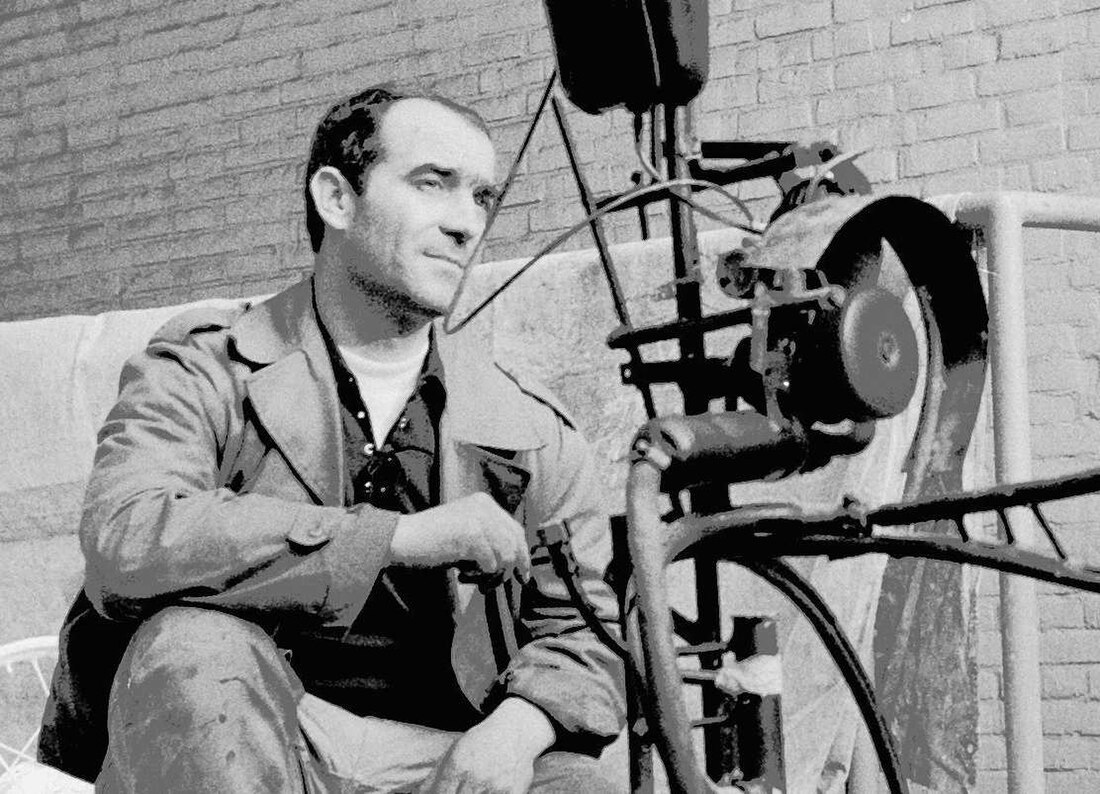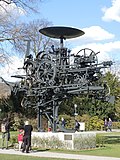Jean Tinguely
Swiss sculptor (1925–1991) From Wikipedia, the free encyclopedia
Jean Tinguely (22 May 1925 – 30 August 1991) was a Swiss sculptor best known for his kinetic art sculptural machines (known officially as Métamatics) that extended the Dada tradition into the later part of the 20th century.[1] Tinguely's art satirized automation and the technological overproduction of material goods.
Jean Tinguely | |
|---|---|
 Jean Tinguely, 1961 | |
| Born | 22 May 1925 Fribourg, Switzerland |
| Died | 30 August 1991 (aged 66) Bern, Switzerland |
| Known for | Painting, Sculpture |
| Spouses |
|
| Partner | Milena Palakarkina (1986–1991) |
Life
Summarize
Perspective
Born in Fribourg, Tinguely grew up in Basel, and in 1941-1945 studied at the Kunstgewerbeschule.[2] He moved to France in 1952 with his first wife, Swiss artist Eva Aeppli,[3] to pursue a career in art. He belonged to the Parisian avant-garde in the mid-twentieth century and was one of the artists who signed the New Realist's manifesto (Nouveau réalisme) in 1960.[1]



His best-known work, a self-destroying sculpture titled Homage to New York (1960), only partially self-destructed at the Museum of Modern Art in New York City,[4][5][6] although his later work, Study for an End of the World No. 2 (1962), detonated successfully in front of an audience gathered in the desert outside Las Vegas.[7] Then in 1961 Tinguley's work was included in the landmark "Art of Assemblage" exhibition at MoMA curated by William C. Seitz.[8] Seitz said of Tinguely in the exhibition's catalogue [that his] ..."most recent work, influenced by Rauschenberg and Stankiewicz, fuses the tradition of kinetic art with that of assemblage"....[9]
Tinguely married fellow Swiss artist Eva Aeppli in 1951.
In 1971, he married his second wife Niki de Saint Phalle with whom he collaborated on several artistic projects, such as the Hon – en katedral[10] or Le Cyclop.[11] Tinguely and Saint Phalle collaborated artistically for over three decades.[12]
Tinguely died of heart failure in 1991 at the age of 66 in the Inselspital in Bern.
Legacy
There have been three major retrospectives of Tinguely's work in the last few decades, firstly in 1987 at the Palazzo Grassi In 1987 in Venice, secondly the "Jean Tinguely: Machine Spectacle" at the Stedelijk Museum in Amsterdam which ran from October 2016 untiil.March 2027, and thirdly at the Hangar PirelliBicocca in Milan from the fall of 2024 into the early winter of 2025.[13][14][15]
Public works
Summarize
Perspective
- Chaos I (1974), sculpture in The Commons, Columbus, Indiana, US
- Le Cyclop outside of Milly-la-Forêt.
- The Stravinsky Fountain (fr: La Fontaine Stravinsky) near the Centre Pompidou, Paris (1983), a collaboration with Niki de Saint Phalle.
- Carnival Fountain (Fasnachtsbrunnen) (1977) in Basel.
- Tinguely Fountain (1977) in Basel.
- Lifesaver Fountain on Königstrasse in Duisburg, Germany, a collaboration with Niki de Saint Phalle
- Jo Siffert Fountain (commonly called Tinguely Fountain), Fribourg, Switzerland
- La Cascade, sculpture in the Carillon Building lobby, Charlotte, North Carolina, US
- Métamatic generative sculptures (1950s)
- Luminator (1991), on loan until 2014 to the EuroAirport Basel-Mulhouse
- Heureka, (1964) "Zürihorn" at Zürichsee, Zürich Switzerland
Hon – en katedral
Hon – en katedral (Swedish: "She, a Cathedral") was an art installation made in collaboration with Niki de Saint-Phalle that was shown at the Moderna Museet in Stockholm in 1966. The exhibition consisted of a sculpture of a colorful pregnant woman lying on her back with her legs wide apart. The sculpture was 25–26 meters long, about 6 meters high and 11 metres wide. It was built of scaffolding and chicken wire covered with fabric and fiberglass, painted with brightly coloured poster paint. Through a door-sized entry in the location of the woman's vagina, visitors could go into the sculpture. Inside was a screen showing Greta Garbo films, a goldfish pond, and a soft drink vending machine. Johann Sebastian Bach's organ music played through speakers. The exhibition was created by Saint-Phalle, Tinguely, and Per Olov Ultvedt. It had 80,000 visitors during the exhibition period from 4 June to 9 September 1966.
Noise music recordings
- 1963 "Sounds of Sculpture", 7", Minami Gallery, Tokyo, Japan_[Tinguely's sculptures recorded by avant-garde composer Toshi Ichiyanagi during Japanese exhibition]
- 1972 'Méta', book+7_, Propyläen Verlag, Stockholm
- 1983 'Sculptures at The Tate Gallery, 1982'_, Audio Arts cassette
- 1983 'Meta-Harmonie H' incl. in ‘Meridians 2_ compilation cassette, Touch
- 1994/5 'Bascule VII', 10”, Manhood Records 002
- 2001 'Relief Meta-Mechanique Sonore I' incl. in 'A Diagnosis' compilation, Revolver-Archiv für Aktuelle Kunst, Frankfurt am Main, Germany
Influence on others
- In Arthur Penn's Mickey One (1965) the mime-like Artist (Kamatari Fujiwara) with his self-destructive machine is reminiscent of Tinguely[16]
- Survival Research Laboratories, directed by Mark Pauline (USA)
- Prominent kinetic sculptor Arthur Ganson described Tinguely as his "primary spiritual artistic mentor", and paid homage to him in his work "Tinguely in Moscow".[17]
Gallery
- Tinguely, Machines - Le Transport, early 1960s; scrap metal components
- Tinguely, Gears, 1967; scrap old metal components (part of Le Paradis Fantastique)
- Tinguely, Chaos I, 1971–72; scrap metal components
- Tinguely, Large Spiral, 1971–73; steel-plates
- Tinguely, Heureka, 1972–73; scrap metal components
- Tinguely, detail of Heureka, 1972–73; old components
- Tinguely, one piece of Carneval Fountain, 1977; location: in front of Museum Tinguely, Basel
- Tinguely, title unknown, late 1970s; scrap metal components
- Tinguely, Jo Siffert Fountain, 1984; scrap metal components
- Tinguely, Press pour oranges in Louvre Abu Dhabi
See also
Further reading
- Museum Tinguely in Basel
- Chapter on Tinguely in Calvin Tomkins' The Bride and Her Bachelors.
- K.G. Pontus Hultén: Jean Tinguely 'Méta'. London: Thames & Hudson, 1975 (original German version Frankfurt/M.: Ullstein, 1972)
- G. Bischofsberger: Catalogue raisonné, 3 Vols. Basel, 1982.
- Margit Hahnloser-Ingold: Pandämonium – Jean Tinguely. Bern: Benteli, 1988 (rather hagiographic, but with interesting personal memories and background material)
- Heidi E. Violand: Jean Tinguely's Kinetic Art or A Myth of the Machine Age. Diss, New York University, 1990
- Museum Jean Tinguely (eds.): Die Sammlung. (The collection) Bern: Benteli, 1996 (incl. an interesting biographical report by Margit Hahnloser: "Jean Tinguely und die Schweiz")
- Museum Jean Tinguely (eds.): Jean le Jeune. Basel: Benteli, 2002 (incl. a biographical text by Jocelyn Daignes about Tinguely's early love of materials and machines, his pacifism, and his Catholicism, p. 23-65).
References
External links
Wikiwand - on
Seamless Wikipedia browsing. On steroids.










